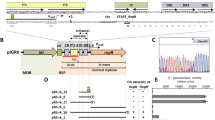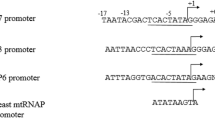Summary
The replication initiation protein π of the Escherichia coli plasmid R6K is a dual regulator in the control of plasmid copy number, functioning both as a specific initiator and inhibitor of replication. While the biochemical basis of these activities is not known, initiator activity requires binding of the protein to the seven 22 by direct repeats within the γ-origin region. By deleting C-terminal segments of the π coding region, we have found that the N-terminal polypeptides of π that are produced, corresponding to the first 117 and 164 amino acids, respectively, retain the negative activity of the bifunctional protein, i.e. these truncated π proteins specifically inhibit R6K replication in vivo. These negatively acting polypeptides, however, are incapable of initiating replication in vivo and fail to bind to the γ-origin of the R6K DNA in vitro. A correspondence between the observed negative activity of the N-terminal peptide and the negative regulatory activity of the intact π protein is supported by the finding that point mutations introduced into the 164 amino acid N-terminal peptide that result in a decrease in its inhibitory activity also produce a plasmid high-copy phenotype when these mutations are incorporated into the full-length π protein. These findings demonstrate that the negative domain of π resides in the N-terminal segment of the protein. Furthermore, the data obtained suggest that inhibition of R6K replication by π does not require direct binding to DNA.
Similar content being viewed by others
References
Bagdasarian M, Lurz R, Rückert B, Franklin FCH, Bagdasarian MM, Frey J, Timmis KN (1981) Specific-purpose plasmid cloning vectors II. Gene 16:237–247
Better M, Freifelder D (1983) Studies on the replication of Escherichia coli phage λ DNA. Virology 126:168–182
Birnboim HC, Doly J (1979) A rapid alkaline extraction method for the isolation of plasmid DNA Nucleic acids Res 7:1513–1521
Casadaban M, Cohen SN (1980) Analysis of gene control signals by DNA fusion and cloning in Escherichia coli. J Mol Biol 138:179–207
Filutowicz M, Davis G, Greener A, Helinski DR (1985a) Autorepressor properties of the π initiation protein encoded by plasmid R6K. Nucleic Acids Res 13:103–114
Filutowicz M, McEachern MJ, Greener A, Mukhopadhyay P, Uhlenhopp E, Durland R, Helinski DR (1985b) Role of the n initiation protein and direkt nucleotide sequence repeats in the regulation of plasmid R6K replication. In: Helinski DR, Cohen S, Clewell DB, Jackson DA, Hollaender A (eds) Plasmids in Bacteria, Plenum Press, New York, pp 125–140
Filutowicz M, McEachern MJ, Helinski DR (1986a) Positive and negative roles of an initiator protein at an origin of replication. Proc Natl Acad Sci USA 83:9645–9649
Filutowicz M, Uhlenhopp E, Helinski DR (1986b) Binding of purified wild-type and mutant π initiation proteins a replication origin region of plasmid R6K. J Mol Biol 187:225–239
Filutowicz M, McEachern MJ, Mukhopadhyay P, Greener A, Yang S, Helinski DR (1987) DNA and protein interactions in the regulation of plasmid replication. In: Davies JW, Hull R, Chater KF, Ellis THN, Lomonossoff GP, Woolhouse HW (eds) The Company of Biologists Limited. J Cell Sci Suppl 7, Cambridge, pp 15–31
Gribskov M, Burgess RR (1983) Overexpression and purification of the σ subunit of Escherichia coli RNA polymerase. Gene 26:109–118
Inuzuka M, Wada Y (1985) A single amino acid alteration in the initiation protein is responsible for the DNA overproduction phenotype of copy mutants of plasmid R6K. EMBO J 4:2301–2307
Kelley W, Bastia D (1985) Replication initiator protein of plasmid R6K autoregulates its own synthesis at the transcription step. Proc Natl Acad Sci USA 82:2574–2578
Kolter R (1979) PhD dissertation. University of California, San Diego USA. Structure and Regulation of a Plasmid Replicon.
Kolter R, Inuzuka M, Helinski DR (1978) Trans-complementation dependent replication of a low molecular weight origin fragment from plasmid R6K. Cell 15:1199–1208
Maniatis T, Fritsch EF, Sambrook J (1982) Molecular cloning: a laboratory manual. Cold Spring Harbor Laboratory Press, Cold Spring Harbor, NY
Maxam A, Gilbert W (1980) Sequencing end-labeled DNA with base-specific chemical cleavages. Methods Enzymol 65:499–560
McEachern MJ (1987) PhD dissertation. University of California, San Diego, USA
McEachern MJ, Filutowicz M, Helinski DR (1985) Mutations in direct repeat sequences and in a conserved sequence adjacent to the repeats result in a defective replication origin in plasmid R6K. Proc Nail Acad Sci USA 82:1480–1484
McEachern MJ, Bott MA, Tooker PA, Helinski DR (1989) Negative control of plasmid R6K replication: Possible role of intermolecular coupling of replication origins. Proc Natl Acad Sci USA 86:7942–7946
Miller JH (1972) Experiments in Molecular Genetics. Cold Spring Harbor Laboratory Press, Cold Spring Harbor, NY
Mukherjee S, Patel I, Bastia D (1985) Conformational changes in a replication origin induced by an initiator protein. Cell 43:189–197
Mukhopadhyay P, Filutowicz M, Helinski DR (1986) Replication from one of the three origins of the plasmid R6K requires coupled expression of two plasmid encoded proteins. J Biol Chem 261:9534–9539
Shafferman A, Helinski DR (1983) Structural properties of the β origin of replication of plasmid R6K. J Biol Chem 258:4083–4090
Shafferman A, Kolter R, Stalker DM, Helinski DR (1982) Plasmid R6K DNA replication. III. Regulatory properties of the π initiation protein. J Mol Biol 161:57–76
Southern EM (1975) Detection of specific sequences among DNA fragments separated by gel electrophoresis. J Mol Biol 98:503–517
Stalker DM, Kolter R, Helinski DR (1979) Nucleotide sequence of the region of an origin of replication of the antibiotic resistance plasmid R6K. Proc Natl Acad Sci USA 76:1150–1154
Stalker DM, Filutowicz M, Helinski DR (1983) Release of initiation control by a mutation in the plasmid encoded protein required for R6K DNA replication. Proc Natl Acad Sci USA 80:5500–5504
Towbin M, Stachelin T, Gordon J (1979) Electrophoretic transfer of proteins from polyacrylamide gels to nitrocellulose sheets: Procedure and some applications. Proc Nail Acad Sci USA 76:4350–4354
Yanisch-Perron C, Vieira J, Messing J (1985) Improved M13 phage vectors and host strains: nucleotide sequences of the Ml3mp18 and pUC19 vectors. Gene 33:103–119
Author information
Authors and Affiliations
Additional information
Communicated by W. Goebel
Rights and permissions
About this article
Cite this article
Greener, A., Filutowicz, M.S., McEachern, M.J. et al. N-terminal truncated forms of the bifunctional π initiation protein express negative activity on plasmid R6K replication. Molec. Gen. Genet. 224, 24–32 (1990). https://doi.org/10.1007/BF00259447
Received:
Issue Date:
DOI: https://doi.org/10.1007/BF00259447




